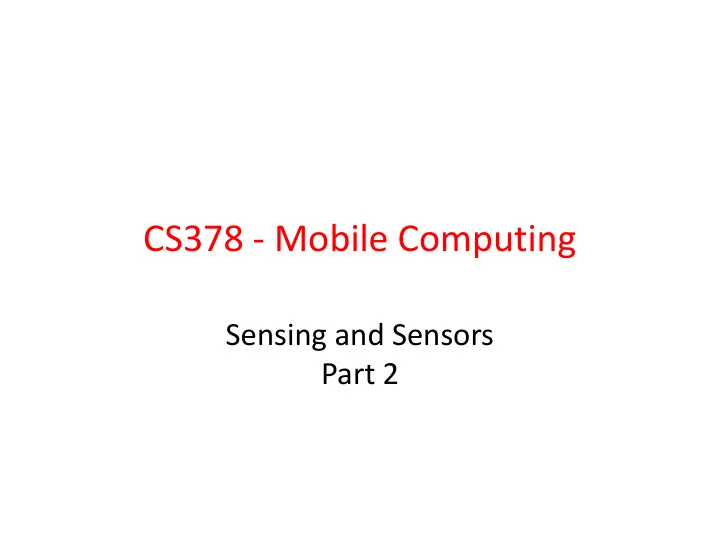

CS378 - Mobile Computing Sensing and Sensors Part 2
Using Sensors • Recall basics for using a Sensor: – Obtain the SensorManager object – create a SensorEventListener for SensorEvents – logic that responds to sensor event – Register the sensor listener with a Sensor via the SensorManager 2
Sensor Best Practices • Unregister sensor listeners – when done with Sensor or activity using sensor paused (onPause method) – sensorManager. unregisterListener(sensorListener) – otherwise data still sent and battery resources continue to be used 3
Sensor Best Practices • Testing on the emulator • Android SDK doesn't provide any simulated sensors • 3 rd party sensor emulator • http://code.google.com/p/openintents/wiki/SensorSimulator 4
SensorSimulator • Download the Sensor Simulator tool • Start Sensor Simulator program • Install SensorSimulator apk on the emulator • Start app, connect simulator to emulator, start app that requires sensor data 5
Sensor Simulator 6
Sensor Simulator • Mouse in Sensor Simulator controls phone, feeds sensor data to emulator • Can also record sensor data from device and play back on emulator 7
Sensors Best Practices • Don't block the onSensorChanged() method – recall the resolution on sensors – 50 updates a second for onSensorChange method not uncommon – when registering listener update is only a hint and may be ignored – if necessary save event and do work in another thread or asynch task 8
Sensors Best Practices • verify sensor available before using it • use getSensorList method and type • ensure list is not empty before trying to register a listener with a sensor 9
Sensors Best Practices • Avoid deprecated sensors and methods • TYPE_ORIENTATION and TYPE_TEMPERATURE are deprecated as of Ice Cream Sandwich 10
Sensor Best Practices • Testing on the emulator • Android SDK doesn't provide any simulated sensors • 3 rd party sensor emulator • http://code.google.com/p/openintents/wiki/SensorSimulator 11
SensorSimulator • Download the Sensor Simulator tool • Start Sensor Simulator program • Install SensorSimulator apk on the emulator • Start app, connect simulator to emulator, start app that requires sensor data 12
Sensor Simulator 13
Sensor Simulator • Mouse in Sensor Simulator controls phone, feeds sensor data to emulator • Can also record sensor data from device and play back on emulator 14
Sensor Sample - Moving Ball • Place ball in middle of screen • Ball has position, velocity, and acceleration • acceleration based on linear acceleration sensor • update over time, based on equations of motion, but fudged to suit application 15
Sensor Sample - Moving Ball • Gross Simplification • velocity set equal to acceleration 16
Sensor Sample - Moving Ball • Alternate Implementation • position updated in separate thread which redraws the view 17
Sensor Sample • Draw lines for x and y velocities 18
Demo Using SensorSimulator 19
Sensor Sample - TBBT • Inspired by http://tinyurl.com/7rnbgy5 and http://tinyurl.com/6nhvnnv 20
TBBT Sound Effect App 21
Responding to Events 22
Changing Images • Use of an Image View • Initial Image set in onCreate • new image set in onSensorChange • register listener with MediaPlayer • on completion reset image 23
Recommend
More recommend